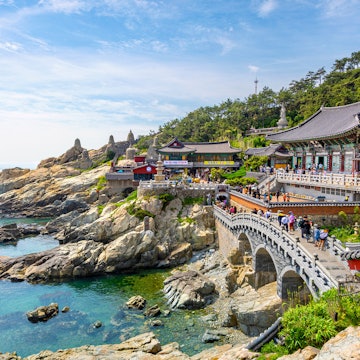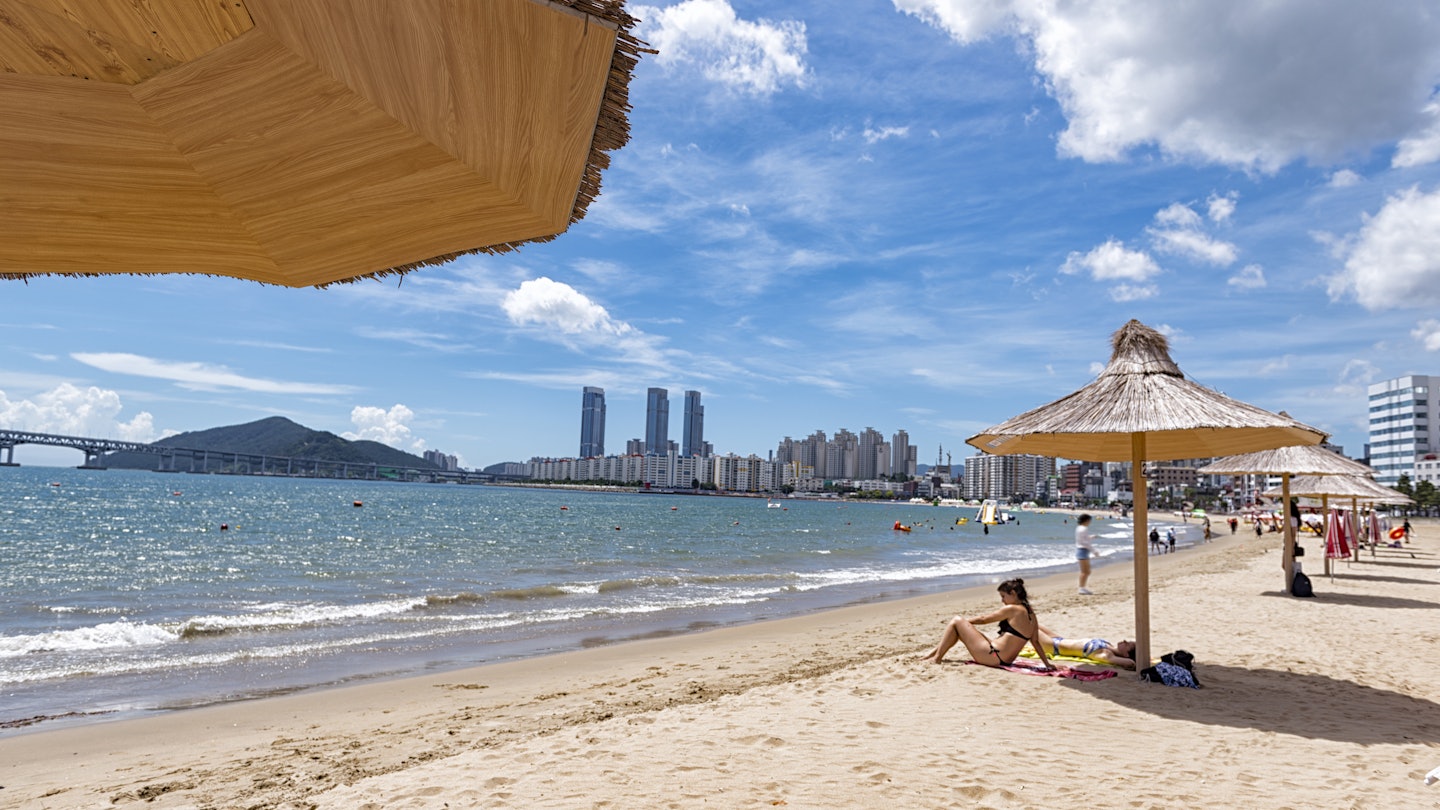
South Korea’s top beaches for sunrises, surfing, festivals and nightlife

Aug 15, 2022 • 9 min read

South Korea may be famed for its mountains, but it's also got incredible beaches © Goldcastle7 / Getty Images
South Korea’s pop culture and dramatic mountains can make it easy to overlook just how good of a beach destination the country is. Surrounded by ocean on three sides and with countless islands sprinkled off its coastlines, South Korea has no end of shores to explore.
Travel the country’s beaches and what you’ll be most struck by is just how diverse they are. From Busan’s urban oases and Jeju-do Island’s subtropical sanctuaries to the east coast’s smooth stretches of sand and the west coast’s dramatic tides, you’ll find a beach for every mood and every moment.
Here are six sandy suggestions in South Korea to get you started.
Get muddy at Daecheon Beach
Daecheon Beach has a real Jekyll and Hyde thing going on. For most of the year, it’s a relatively low-key place – kind of touristy with lots to do, but still sort of sleepy. But for a month each summer, it loses its mind.
For several weeks spanning July and August, Daecheon is the site of the Boryeong Mud Festival, which is a bit like Cancún during spring break if all the partiers kept their shirts on. The festival is nominally held to celebrate the city of Boryeong’s mineral-rich mud, which is used in commercial skin care products and is said to have all sorts of health benefits, from anti-aging to improved blood circulation. Commemorations are held in the form of mud marathons, mud obstacle courses, mud slides, mud face painting, mud massages, and concerts and DJ sets in the mud. The festival draws huge crowds of mostly young people, but it’s a PG party, and plenty of families take part, too.
It’s in the other 11 months of the year that you can better appreciate just how nice of a beach Daecheon is. At 3.5km (2.2 miles) long and 100m (328ft) wide, it’s the west coast’s largest beach. (The water on the west coast is also warmer than at east coast beaches.) It’s also probably the most active, offering water-skiing, jet skiing, banana boat rides, a zip line and a rail bike that runs on an elevated track along the shore. You can also take a boat out to Dabo-do Island, an uninhabited, rocky islet. At just 2.5 hours from Seoul by bus or train, Daecheon makes for an easy weekend away from the capital.

Haeundae Beach is for seeing and being seen
Haeundae takes its moniker from the Silla-era scholar and poet Choe Chi-won, who was so fond of the beach that he carved his pen name, Haeun, into a nearby rock. More than 1000 years later, it’s a tough place to write poetry.
Haeundae is South Korea’s most popular beach by some margin, and it’s not hard to see why: 1.5km (0.93 miles) long, with calm, shallow water and surrounded by some of Korea’s glitziest real estate, it’s a fabulous place to be. In July and August, the Busan beach is packed with tourists, families and people looking to see and be seen. Koreans are not sunbathers, and during summer’s peak, much of the sand is covered by beach umbrellas, leaving Haeundae looking like a patchwork quilt when viewed from above. Come at other times of the year, however, and you’ll find no shortage of places to spread out your towel.
Haeundae’s appeal lies just as much in the attractions surrounding the sand. In the middle of the beach you’ll find SEA LIFE Busan Aquarium, where you can see otters, penguins and turtles and watch twice-daily shark feedings. At the beach’s east end are an arts center, club and the BUSAN X the SKY observation deck. To the west are Haeundae Pojangmacha-chon, a collection of tent restaurants serving seafood, and Dongbaek Park, a forested promontory with walking trails, a lighthouse and Nurimaru APEC House, which was built to host the 2005 APEC summit. To the north, between the beach and Haeundae subway station, the streets are packed with cafes, restaurants and bars.
The beach and its surroundings also host numerous festivals throughout the year. Hardy souls plunge into the sea at the Haeundae Polar Bear Festival each January, while in May, the beach is the setting for incredible sand sculptures during the Haeundae Sand Festival. At the height of summer, the Busan Sea Festival sees concerts held at Haeundae and two other Busan beaches: Gwangalli and Dadaepo.

Find waves and good vibes at Jukdo Beach and Ingu Beach
It surprises a lot of people to learn that Korea has a surfing scene, but it does, and this pair of beaches in Yangyang-gun County is its epicenter.
Yangyang’s a vibe. Near the beach, surfers stroll around with longboards, and Seoul escapees snap pics for social media, but just a block inland, the place is still your typical rural Korean town, with old farmers rolling by in pickup trucks. It’s one of the few places in the country where it feels like the stresses of normal Korean life don’t apply.
Jukdo and Ingu are separated by a tree-covered hill. The 2km-long (1.25-mile) Jukdo is the quieter sibling, whereas Ingu is a bit more built up and has most of the beaches’ nightlife. Both are home to numerous surf shops offering surfing lessons and board rentals. If you’ve never surfed before, this beach isn’t a bad place to try for the first time. Waves are modest, Korean surf culture is welcoming and you definitely won’t be the only novice on the swells. You shouldn’t have much difficulty finding an instructor who speaks English. Surf Ocean and Tyler’s Longboard Shop are good options for lessons. If you’re an experienced surfer, you’ll find Yangyang’s best waves in winter.
Jukdo and Ingu both have plenty of cafes, restaurants and bars that make up the post-surfing scene. In Jukdo, Mahalo hotel and cafe has floor-to-ceiling windows that look out over the waves, while in Ingu, both Please Wait and Surf Cliff come alive with DJs and live music after the sun goes down.
Have a family day out at Woljeongri Beach
It’s hard to pick the best beach on Jeju-do Island, but Woljeongri makes a strong case. Located on the island’s northeastern tip, it’s a cute little half moon of white sand leading into jewel-like turquoise water, the sort of palette that calls to mind the South Pacific. While there are some swells farther out that local surfers like to ride, near shore the water is shallow and tranquil, perfect for toddlers and kids to play in, making this one of Korea’s best beaches for families.
Beyond the sand, the village of Woljeong-ri is an ideal base for any Jeju vacation. Walk through its quaint streets and you’ll come across signs of both old (traditional walls made of volcanic stone) and new (trendy restaurants and cafes ready with cool drinks when you need a break from the sun). For a truly local experience, look into staying somewhere like Sogeun Sogeun, a charming bed-and-breakfast in a traditional Jeju-style home.
If you’re visiting Woljeongri with kids and they get bored with the beach, Gimnyeong Maze Park and the otherworldly Manjang-gul lava tube are both less than a 10-minute drive, while a section of the Jeju Olle Trail passes right by the beach.

Jeongdongjin Beach is serene at sunrise – and an easy day trip from Seoul
If you love to be at the beach but hate the hassle of going to the beach, Jeongdongjin Beach is your spot. Catch a train from Seoul Station and just a two-hour nap later, you’ll be on the sand. Not “15-minute-walk-from-the-station” at the beach or “short-cab-ride” at the beach, but at-the-beach at the beach. The Guinness Book of World Records has recognized Jeongdongjin Station as the closest station to a beach in the world; its tracks run right along the sand.
Jeongdongjin is a spacious strip of golden sand with some rocky outcroppings. A lot of folks stick to the section of beach closest to the station for convenience, but if you hike about 400m (0.25 miles) south, you’ll find a good expanse of sand in front of Morae Shigae (Hourglass) Park. Just try to ignore the monstrosity that is Sun Cruise, a hotel shaped like a pair of cruise ships perched atop a cliff. Jeongdongjin is famed for its sunrises, and on any given day, Koreans will be on the sand in the pre-dawn hours waiting for the sun to emerge from the sea. It's an especially popular activity on New Year’s Day.
A rail bike track, on which you pedal a two- or four-person cart along railroad tracks, loops along the beach, with boarding points at both Jeongdongjin Station and Morae Shigae Park. Restaurants, cafes and convenience stores can be found all along Jeongdongyeok-gil and Heonhwa-ro streets.
Live the resort life at Jungmun Saekdal Beach
On Jeju-do Island’s south coast 15km (9.3 miles) west of Seogwipo is Jungmun Saekdal Beach. If you’re looking for a private strip of sand where you can tune out the world and let the white noise of breaking waves wash over you, keep moving. But if you’re after a beach where there’s lots to do and plenty of resorts to pick from, this is your spot.
Jungmun Saekdal is located within the Jungmun Tourist Complex, a collection of leisure facilities and resorts (you don’t have to stay at one of them to use the beach), and it doesn’t take a developer’s imagination to see why the complex was established here. Black volcanic cliffs bookend a 560m (0.35-mile) stretch of mottled red, black, white and gray sand. A dense screen of greenery insulates the beach from the built-up portions of the tourist complex, and palm trees look out over blue subtropical waters.
Respectable waves make this one of Korea’s top surfing destinations, and it’s also a popular spot for water-skiing, parasailing, windsurfing and other water sports. The young and the beautiful gravitate to The Cliff, a restaurant and bar at the east end of the beach with bean bag chairs, daybeds, DJs spinning house and techno, party yachts and exquisite sunset views. Active types will appreciate that not far from the beach are the Jungmun Golf Club, the three-tier Cheonjeyeon Waterfall and a section of the Jeju Olle Trail that leads to panoramic views at the top of a volcanic tuff cone. Families and those who appreciate the works of Seurat and Michelangelo but always thought their oeuvres could use more stuffed animals should check out the Teddy Bear Museum, a 20-minute walk from the beach.















